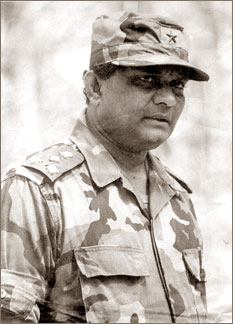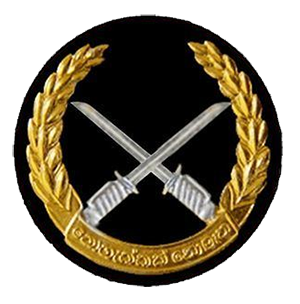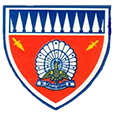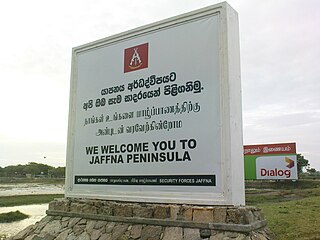
Lieutenant General Denzil Lakshman Kobbekaduwa, RWP, RSP, VSV, USP was a senior Sri Lankan Army officer who served in the 1971 Insurrection and the Sri Lankan Civil War.

Major General Vanigamuni Indrajith Vijeyakumar Mendis Wimalaratne, RWP, RSP, VSV, USP was a senior Sri Lanka Army officer. One of the most distinguished field commanders in Sri Lanka, Wimalaratne raised the Gajaba Regiment, he commanded the 1st Brigade during the Vadamarachchi Operation, he commanded the Amphibious Task Force Commander during Operation Balavegaya and was the Commander Security Forces – Jaffna at the time of his death in a land mine explosion at Point Arali in the Kayts Island while making preparations to re-capture Jaffna.

Indian Peace Keeping Force (IPKF) was the Indian military contingent performing a peacekeeping operation in Sri Lanka between 1987 and 1990. It was formed under the mandate of the 1987 Indo-Sri Lankan Accord that aimed to end the Sri Lankan Civil War between Sri Lankan Tamil militant groups such as the Liberation Tigers of Tamil Eelam (LTTE) and the Sri Lankan military.

The Sri Lanka Army is the oldest and largest of the Sri Lanka Armed Forces. Established as the Ceylon Army in 1949, it was renamed when Sri Lanka became a republic in 1972. In 2010, the Army had approximately 200,000 regular personnel, between 20,000 and 40,000 reserve (volunteer) personnel and 18,000 National Guardsmen and comprises 13 divisions, one air-mobile brigade, one commando brigade, one special forces brigade, one independent armored brigade, three mechanized infantry brigades and over 40 infantry brigades.
Operation Pawan was the code name assigned to the operation by the Indian Peace Keeping Force (IPKF) to take control of Jaffna from the Liberation Tigers of Tamil Eelam (LTTE), better known as the Tamil Tigers, in late 1987 to enforce the disarmament of the LTTE as a part of the Indo-Sri Lanka Accord. In brutal fighting lasting about three weeks, the IPKF took control of the Jaffna Peninsula from the LTTE, something that the Sri Lankan Army had tried but failed to do. Supported by Indian Army tanks, helicopter gunships and heavy artillery, the IPKF routed the LTTE at the cost of 214 soldiers and officers.Many Indian soldiers died

The Commando Regiment is the commando formation of the Sri Lanka Army. The unit specializes in various roles including hostage rescue, counter-terrorism, unconventional warfare, special reconnaissance, counter-insurgency, and personnel recovery. It was formed in 1980 and is based in Ganemulla, a suburb of Colombo.

The Sri Lanka Armoured Corps (SLAC) provides the armour capability of the Sri Lanka Army, with vehicles such as the T-55AM2, and type 80/88 main battle tanks; the BMP infantry fighting vehicle; and the BTR-80, and WZ551 armoured personnel carriers. It comprises six regular armoured regiments, a volunteer regiment, and a regimental band. It has an independent Armoured Brigade and is headquartered at Rock House Army Camp, Colombo.

The Gemunu Watch (GW) ("King Dutugemunu's Own") is a infantry regiment of the Sri Lanka Army, formed with troops from the Ceylon Light Infantry and the Ceylon Sinha Regiment in 1962. It has been deployed in many major operations against the LTTE. It is made up of 14 regular units and 9 volunteer units. Headquartered at Kuruwita Army Camp, Ratnapura. It is named after one of the most famous Lankan Kings, King Dutugemunu.
The Battle of Mullaitivu, also known as the First Battle of Mullaitivu and codenamed Operation Unceasing Waves-1, was a battle between the militant Liberation Tigers of Tamil Eelam and the Sri Lankan military during the Sri Lankan Civil War for control of the military base in Mullaitivu in north-eastern Sri Lanka.
The Second Battle of Elephant Pass, was a battle fought in April 2000 for the control of the Sri Lankan military base in Elephant Pass, Jaffna.
Operation Riviresa, was a combined military operation launched by the Sri Lankan Armed Forces in Jaffna. Starting on 17 October 1995, the primary objective of the operation was the capture of the city of Jaffna and rest of the Jaffna peninsula from the LTTE. It is believed that Operation Riviresa was the largest and most successful military operation in Sri Lankan Armed Forces during the Third Eelam War.

Major General Janaka Perera, RWP, RSP, VSV, USP, VSP, rcds, psc, CR was a Sri Lankan General and politician. He served as the Chief of Staff of the Sri Lanka Army and is considered one of the most distinguished generals in Sri Lankan history. After retiring from the army he served as a Sri Lankan High Commissioner to Australia and Ambassador to Indonesia. He was the opposition leader of the North Central Provincial Council until he and his wife were killed on 6 October 2008 by a suicide bomber. The LTTE have been blamed for the bombing by Sri Lankan president Mahinda Rajapaksa.

General Tissa Indraka Weeratunga, VSV was a Sri Lankan senior general. He was a former Commander of the Sri Lankan Army and first general officer commanding (GOC) of the Joint Operations Headquarters (JOH), he was later Sri Lanka's High Commissioner to Canada.

Security Forces Headquarters – Jaffna (SFHQ-J) is a regional command of the Sri Lanka Army, that is responsible for the operational deployment and command all army units stationed in and around the Jaffna Peninsula in the Northern Province.
General Shavendra Silva, WWV, RWP, RSP, VSV, USP is a Sri Lanka Army general who is the current Chief of Defence Staff, the head of the Sri Lanka Armed Forces serving from 1 January 2020. He also served as the Commander of the Sri Lanka Army from 19 August 2019 to 31 May 2022. His other important appointments include, Chief of Staff of the army, Adjutant General and Director of Operations of the Army. During the Sri Lankan civil war he gained fame as the General Officer Commanding of the elite 58 Division. He had also served as the Deputy Permanent Representative to the United Nations Headquarters.
General Shantha H.S. Kottegoda, WWV, RWP, RSP, VSV, USP is a retired senior Sri Lanka Army general. He was the seventeenth Commander of the Sri Lankan Army from 1 July 2004 – 5 December 2005. He had served as the Sri Lankan Ambassador to Brazil and Thailand. In April 2019, following the Easter Sunday bombings he was appointed as the Permanent Secretary to the Ministry of Defence.
Major General Jeewaka Ruwan Kulatunga, RSP, ndc, psc, is a retired Sri Lankan general. He served as the Chief of National Intelligence having served as the Commandant of the Defence Services Command and Staff College and the Deputy Vice Chancellor of the General Sir John Kotelawala Defence University.
General N.U.M. Mahesh W. Senanayke, RWP, RSP, VSV, USP is a retired Sri Lankan Army general who served as the Commander of the Sri Lanka Army from 2017 to 2019. Senanayake had previously been the Commander, Security Forces Headquarters – Jaffna, General Officer Commanding, 52 Division and Brigade Commander, Special Forces Brigade. Having started his military career as a military engineer, Senanayake became a special forces officer and is a veteran of all four phases of the Sri Lankan Civil War, he has served in both its Northern and Eastern theaters. Following his retirement, he contested the 2019 Sri Lankan presidential election and came fourth after the three candidates of the three major political parties in the island.
The Battle of Weli Oya, was a battle between the militant Liberation Tigers of Tamil Eelam and the Sri Lanka Army during the Sri Lankan Civil War for control of the military bases in Weli Oya in northern Sri Lanka on 28 July 1995.








